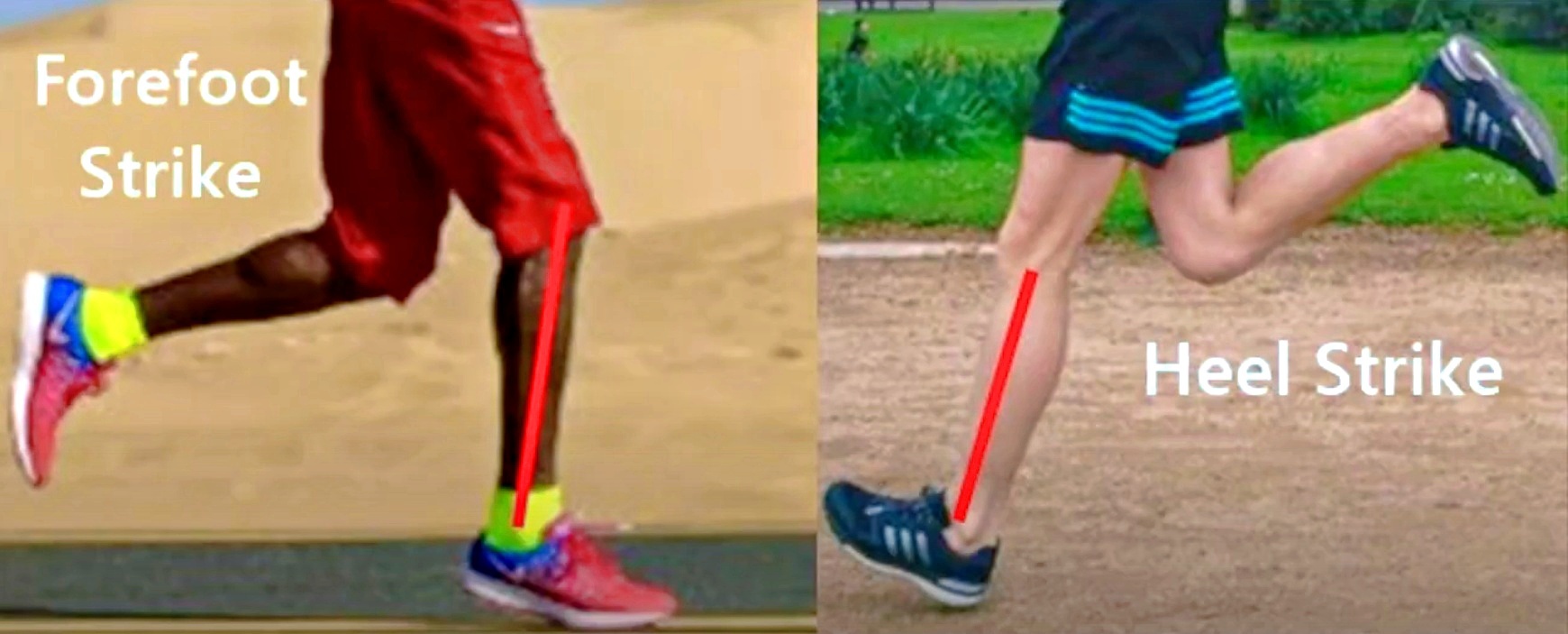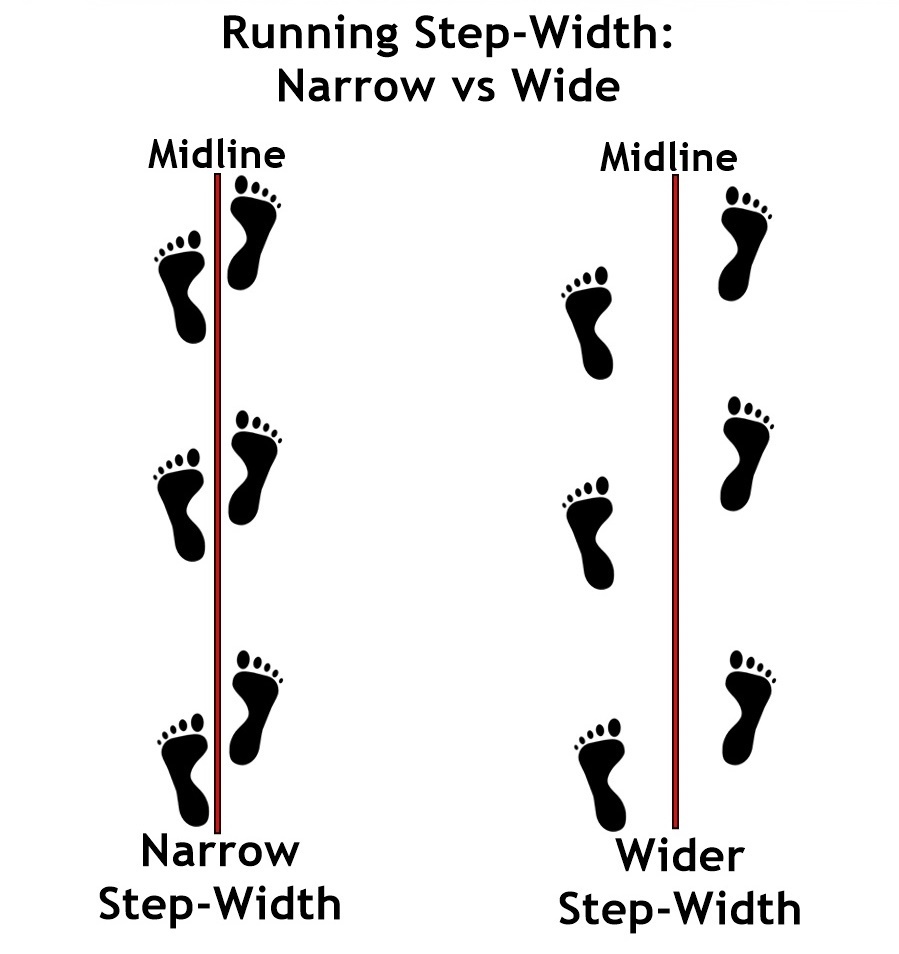Aside from reducing net impacts on the shins, forefoot running also reduces mechanical strain on the shin by improving shin angle at landing as compared with heel strike running.
There are multiple factors responsible for shin injury in running. One factor is a shin that’s angulated away from the upper body at landing, which happens when landing heel-first, but not when landing forefoot-first (shown below).


Forefoot striking naturally aligns the shin towards the upper body (center mass) at landing, which was found to be the most effective at reducing the opposing forces that cause shin splints. Forefoot running enables the shin to angulate closer to the upper body at landing, because as shown above, stride length becomes shorter while stance-width becomes wider.
What is step-width in running?
Step-width is defined as the distance in width between your feet at each step. The illustration below gives a clear-eyed view of a narrow vs a wide running step-width:

There are countless links between increased stance-width and reduced risk of shin splints in running, and a compelling study in the Journal of Biomechanics is just one of them:
- The study investigated the effects of stance-width manipulation on shin strain in runners.
- Runners were given verbal cues to run with a narrower or wider step-width, both of which were to be 5% more or less than their preferred step-width.
The study found that the runners that widened their stance-wdith had the greatest reductions in medial compression and tissue loads on the lower leg as compared with a crossover, or a narrow step-width running gait.
More notably, the researchers found that a wider step-width reduced normal stress loads and anterior tension on the shin. It also significantly reduced posterior and medial tibial compression as well!
By comparison, similar studies found that a narrow running stance-width contributed to chronic shin splints by pushing foot pronation, hip adduction and knee internal rotation out of tolerance, all of which increased the medial-lateral ground reaction force, torsional loading and bending strain on the shins.
The most important takeaway is forefoot running has the most profound corrective effect in bringing together the kind of mechanics that perfectly prevents impact forces and other physical stressors from being too high on the shin. Conversely, heel strike running pulls your mechanics in the opposite direction, pushing all aspects of your stride away from the natural order, thereby creating mechanics that work against you, especially your shins!
Last, but not least, a handy tip to improve stance-width is from Chi Running, which recommends to run over top of the line on the side of the road, making sure your feet land on either side, not on or across the line but rather your running step-width should equal the width of your hip. More on this from Chi Running here!
References:
Meardon SA and Derrick TR. Effect of step width manipulation on tibial stress during running. J Biomech, 2014;47, 2738-2744.
Brindle, R.A., Milner, C.E., Zhang, S., Fitzhugh, E.C., 2013. Changing step width alters lower extremity biomechanics during running. Gait Posture 39, 124–128.
Pohl, M.B., Messenger, N., Buckley, J.G., 2006. Changes in foot and lower limb coupling due to systematic variations in step width. Clin. Biomech. 21, 175–183
McClay, I.S., 1995. The use of gait analysis to enhance the understanding of running injuries. Mosby, St. Louis MO, pp. 395–411.
If you’d like, you can support Run Forefoot and help keep it going by making a donation in any amount of your choosing:

Or, you can also support Run Forefoot by shopping at the following top minimalist shoes brands, and be sure to bookmark the links:
Be Lenka: https://www.dpbolvw.net/click-7600968-14330828
FeelGrounds: https://www.feelgrounds.com/?p=RunForefoot
Xero Shoes: https://xeroshoes.com/go/Run_Forefoot
Iguaneye: https://www.iguaneye.com/?ref=8tfXVc92
Soft Star Shoes: https://shrsl.com/3mp1b
Wilding Shoes: https://bit.ly/3lIygQP
Earth Runners: https://earthrunners.com/?rfsn=6763579.f7f9c9
Vivobarefoot: https://shrsl.com/3kvih
Zappos: https://goo.gl/J1CeAd
Bretta Riches
BSc Neurobiology; MSc Biomechanics candidate, ultra minimalist runner & founder of RunForefoot. I was a heel striker, always injured. I was inspired by the great Tirunesh Dibaba to try forefoot running. Now, I'm injury free. This is why I launched Run Forefoot, to advocate the health & performance benefits of forefoot running and to raise awareness on the dangers of heel striking, because the world needs to know.
Latest posts by Bretta Riches (see all)
- How to Train Yourself to Not Heel Strike When Running - 24/04/2024
- Cushioned Running Shoes Found to Be Bad for Ankles - 23/04/2024
- Forefoot Running and Achilles Pain - 19/04/2024

